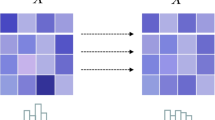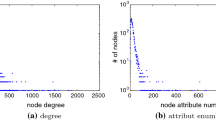Abstract
Network embedding aims to learn low-dimensional representations for nodes in social networks, which can serve many applications, such as node classification, link prediction and visualization. Most of network embedding methods focus on learning the representations solely from the topological structure. Recently, attributed network embedding, which utilizes both the topological structure and node content to jointly learn latent representations, becomes a hot topic. However, previous studies obtain the joint representations by directly concatenating the one from each aspect, which may lose the correlations between the topological structure and node content. In this paper, we propose a new attributed network embedding method, TLVANE, which can address the drawback by exploiting the deep variational autoencoders (VAEs). Particularly, a two-level VAE model is built, where the first-level accounts for the joint representations while the second for the embeddings of each aspect. Extensive experiments on three real-world datasets have been conducted, and the results demonstrate the superiority of the proposed method against state-of-the-art competitors.









Similar content being viewed by others
Notes
References
Belkin M, Niyogi P (2002) Laplacian eigenmaps and spectral techniques for embedding and clustering. In: Advances in neural information processing systems, pp 585–591
Belkin M, Niyogi P (2003) Laplacian eigenmaps for dimensionality reduction and data representation. Neural Comput 15(6):1373–1396
Perozzi B, Al-Rfou R, Skiena S (2014) Deepwalk: online learning of social representations. In: Proceedings of the 20th ACM SIGKDD international conference on knowledge discovery and data mining. ACM, pp 701–710
Cao S, Lu W, Xu Q (2015) Grarep: learning graph representations with global structuralinformation. In: Proceedings of the 24th ACM international on conference on information and knowledge management. ACM, pp 891–900
Tang J, Qu M, Wang M, Zhang M, Yan J, Mei Q (2015) Line: large-scale information network embedding. In: Proceedings of the 24th international conference on world wide web. International world wide web conferences steering committee. pp 1067–1077
Cao S, Lu W, Xu Q (2016) Deep neural networks for learning graph representations. In: The 30th AAAI conference on artificial intelligence, pp 1145–1152
Zhu S, Yu K, Chi Y, Gong Y (2007) Combining content and link for classification using matrix factorization. In: Proceedings of the 30th annual international ACM SIGIR conference on research and development in information retrieval. ACM, pp 487–494
Li J, Zhu J, Zhang B (2016) Discriminative deep random walk for network classification. In: The 54th Annual meeting of the association for computational linguistics
Ng AY, Jordan MI, Weiss Y (2002) On spectral clustering: analysis and an algorithm. In: Advances in neural information processing systems (NIPS), pp 849–856
Huang Z, Ye Y, Li X, Liu F, Chen H (2017) Joint weighted nonnegative matrix factorization for mining attributedgraphs. In: Pacific-Asia conference on knowledge discovery and data mining. Springer, New York, pp 368–380
Gao S, Denoyer L, Gallinari P (2011) Temporal link prediction by integrating content and structure information. In: Proceedings of the 20th ACM international conference on information and knowledge management. ACM, pp 1169–1174
Zhu L, Guo D, Yin J, Ver Steeg G, Galstyan A (2016) Scalable temporal latent space inference for link prediction in dynamic social networks. IEEE Trans Knowl Data Eng 28(10):2765–2777
Tang J, Liu J, Zhang M, Mei Q (2016) Visualizing large-scale and high-dimensional data. In: Proceedings of the 25th international conference on world wide web. International world wide web conferences steering committee, pp 287–297
Qi G-J, Aggarwal C, Tian Q, Ji H, Huang T (2012) Exploring context and content links in social media: a latent space method. IEEE Trans Pattern Anal Mach Intell 34(5):850–862
Wang S, Li X, Ye Y, Huang X, Li Y (2018) Multi-attribute and relational learning via hypergraph regularized generative model. Neurocomputing 274:115–124
Luo D, Nie F, Huang H, Ding CH (2011) Cauchy graph embedding. In: Proceedings of the 28th international conference on machine learning, pp 553–560
Wang D, Cui P, Zhu W (2016) Structural deep network embedding. In: Proceedings of the 22nd ACM SIGKDD international conference on knowledge discovery and data mining. ACM, pp 1225–1234
Li H, Wang H, Yang Z, Liu H (2017) Effective representing of information network by variational autoencoder. In: International joint conference on artificial intelligence, pp 2103–2109
Yang C, Liu Z, Zhao D, Sun M, Chang EY (2015) Network representation learning with rich text information. In: International joint conference on artificial intelligence, pp 2111–2117
Pan S, Jia W, Zhu X, Zhang C, Wang Y (2016) Tri-party deep network representation. Network 11(9):12
Huang X, Li J, Xia H (2017) Accelerated attributed network embedding. In: Proceedings of the 2017 SIAM international conference on data mining
Li F, Ye Y, Tian Z, Zhang X (2018) CPU versus GPU: which can perform matrix computation faster–performance comparison for basic linear algebra subprograms. Neural Comput Appl. https://doi.org/10.1007/s00521-018-3354-z
Kingma DP, Welling M (2013) Auto-encoding variational bayes. arXiv preprint arXiv:1312.6114
Mikolov T, Sutskever I, Chen K, Corrado GS, Dean J (2013) Distributed representations of words and phrases and their compositionality. In: Advances in neural information processing systems, pp 3111–3119
Grover A, Leskovec J (2016) node2vec: Scalable feature learning for networks. In: Proceedings of the 22nd ACM SIGKDD international conference on knowledge discovery and data mining. ACM, pp 855–864
Le Q, Mikolov T (2014) Distributed representations of sentences and documents. In: Proceedings of the 31st international conference on machine learning, pp 1188–1196
Zhang H, Wang S, Mingbo Z, Xu X, Ye Y (2018) Locality reconstruction models for book representation. IEEE Trans Knowl Data Eng 30(10):1873–1886
Zhang H, Wang S, Xu X, Chow TWS, Jonathan Wu QM (2018) Tree2vector: learning a vectorial representation for tree-structured data. IEEE Trans Neural Netw Learn Syst 29(11):5304–5318
Fan R-E, Chang K-W, Hsieh C-J, Wang X-R, Lin C-J (2008) Liblinear: a library for large linear classification. J Mach Learn Res 9:1871–1874
Friedman M (1939) The use of ranks to avoid the assumption of normality implicit in the analysis of variance. Publ Am Stat Assoc 32(200):675–701
Nemenyi P (1962) Distribution-free multiple comparisons. Int Biom Soc 18(2):263
Acknowledgements
This research was supported in part by NSFC under Grant No. 61572158 and No. 61602132, and Shenzhen Science and Technology Program under Grant No. JCYJ20160330163900579, No. JCYJ20170413105929681 and No. JCYJ20170811160212033.
Author information
Authors and Affiliations
Corresponding author
Rights and permissions
About this article
Cite this article
Huang, Z., Li, X., Ye, Y. et al. TLVANE: a two-level variation model for attributed network embedding. Neural Comput & Applic 32, 4835–4847 (2020). https://doi.org/10.1007/s00521-018-3875-5
Received:
Accepted:
Published:
Issue Date:
DOI: https://doi.org/10.1007/s00521-018-3875-5




